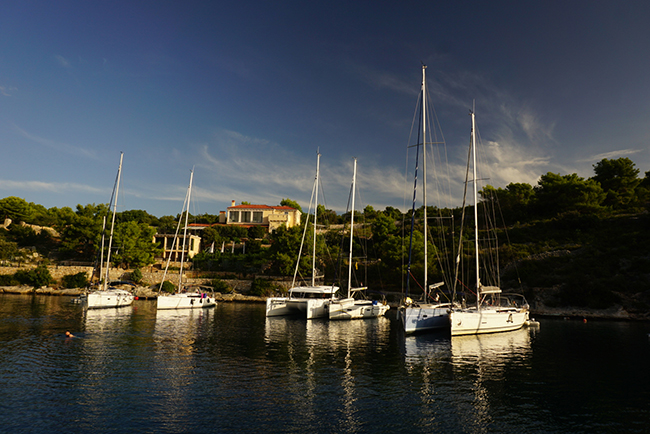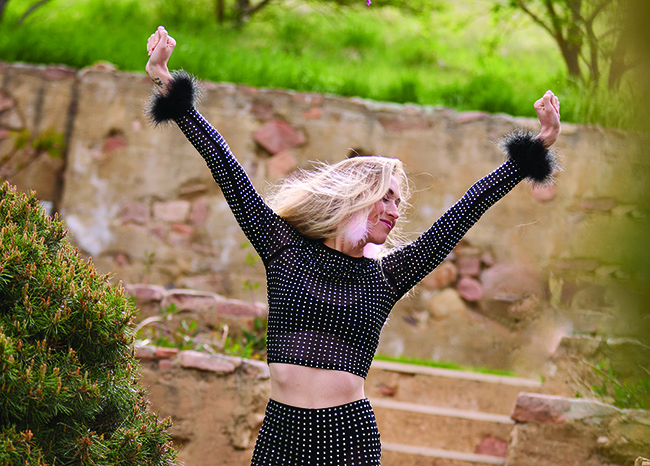What’s SUP?
06 Jun 2024
Paddleboarding the waterways of Boulder and beyond with Rocky Mountain Paddleboard
By Christopher C. Wuensch
Photos by Corbin Spring, Bearded Bros. Media, Beardedbrosmedia.com
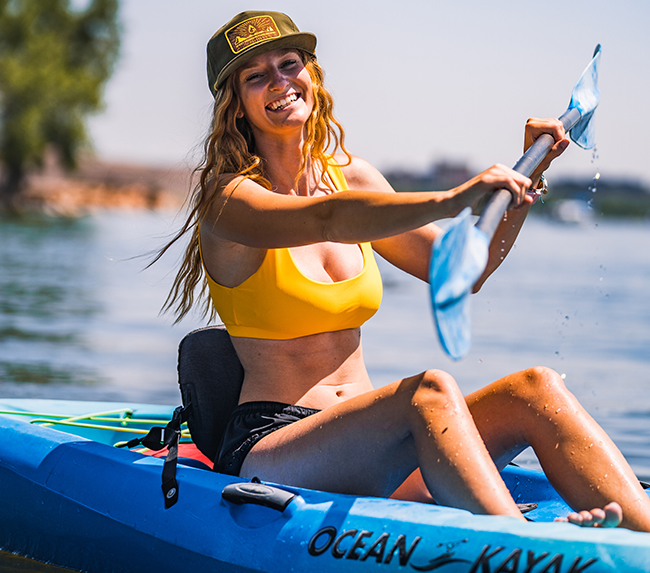
There’s a serenity that spills over you as the wobbliness subsides and the backdrop of the Rocky Mountains begins to flood your senses.
It’s here, surrounded 360 degrees by the mirror-like surface of the calm water, where the reflective beauty whisks away your breath and steers your mind toward a tranquil bliss.
Until the next small wave quickly ripples you back to reality, that is.
Thousands of Colorado residents and serenity-thrill seekers travel from distant locations annually to grab a paddle board and plunge into the waterways of Boulder and beyond.
“There’s a look of joy on people’s faces that’s unmatched,” says Ashley Coil, an instructor and manager with Rocky Mountain Paddleboard, of the sport that doesn’t take much for paddlers to instantly fall in love with.
Paddle Boarding 101
Long before the frigid waters of Boulder County became a hotbed for adventures, centuries ago the seafaring people of Polynesia were incorporating paddle boarding into their everyday lives, from hunting to traveling and exploration.
Unlike traditional surfboards, paddle boards tend to be wider, thicker and shorter to support the weight of a rider for extended distances. Whereas the surfer uses his arms and board to navigate waves, the paddle boarder takes a calmer approach as the rider glides across the top of the water —standing or in a kneeling position—with the use of a paddle. And perhaps some help from the wind.
Boards typically range from 12 feet to 18 feet long for a stock and up, with 14 feet serving as an ideal size. The hard boards are built from epoxy, while inflatable boards offer easier transportation.
The sport began to take on its more contemporary feel in the mid-1920s and ‘30s as pioneers like professional Hawaiian surf rider Thomas Edward Blake crafted and fine-tuned paddle boards into a design that essentially remains to this day.
After resurgences in the ‘80s and ‘90s, paddle boarding, colloquially known as Stand Up Paddleboarding or SUP, has fully entrenched our modern-day sports acumen.
And while perhaps many of the thrill seekers of Boulder might not be quite ready yet to spearfish from their paddleboards, outdoor companies such as Rocky Mountain Paddleboard simply want you to discover the joy of the ancient sport.
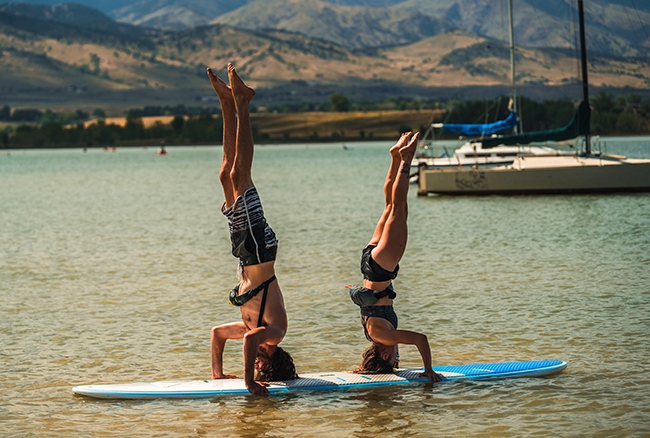
Get to Know Rocky Mountain Paddle Board
Following the waves is Shawn Rodine, founder of Rocky Mountain Paddleboard.
Rodine’s own journey brought him from the surf of Waikiki to the craggy shorelines of Boulder and, in tow, an affinity for life on the water.
A self-professed water addict, Rodine formed Rocky Mountain Paddleboard in 2012 with just five boards and a trailer.
Today, RMPB has more than 100 boards and is situated in four locations in Denver, Lakewood and Longmont, as well as Boulder Reservoir, where the company first pushed off into the water all those years ago.
That arsenal now also includes single and double kayaks, canoes and even party paddle boards and pontoon boats.
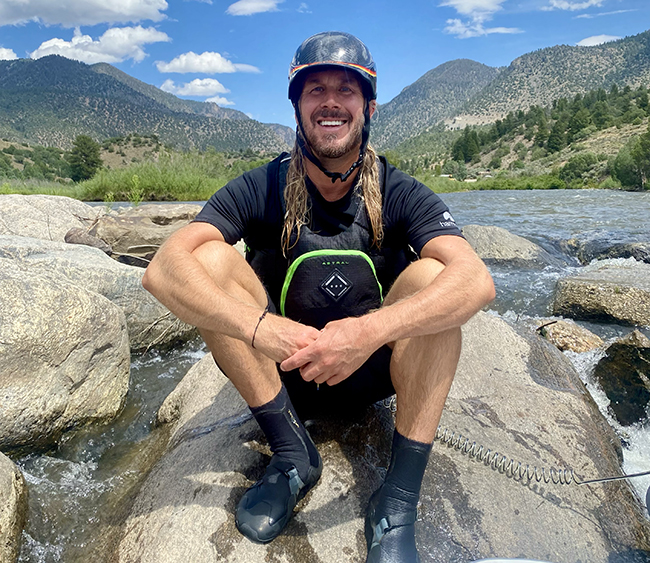
Getting on the Water
Overcoming any trepidation of wading out into the open water is one of the biggest obstacles many face when starting out paddle boarding, explained Coil.
But those fears tend to quickly evaporate for riders of all ages and experiences at the relative ease of getting up on the board.
Rocky Mountain Paddleboard has plenty of options for those first timers looking to get out on the water. Classes are held at all four locations, run for 1.5 hours and taught by certified instructors.
For those experienced boarders looking for more of a challenge, Rocky Mountain Paddleboard has your adrenaline rush, as well.
SUP Yoga is designed to instill serenity, while simultaneously testing your balance. It can be found at all four RMPB locales, where falling in the water is half the fun.
Anyone looking to step up their game even further can test their mettle in one of RMPB’s River Clinics. Based out of River Run Park, the clinics introduce paddling the running water and advance to running the rapids of the South Platte in South Denver.
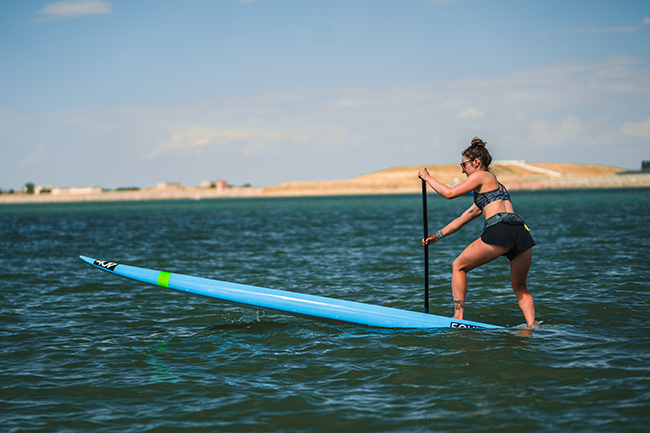
Paddlin’ For Fun
Looking for the fun and adventurous side of paddle boarding?
Rocky Mountain Paddleboard has played host to its Full Moon Paddles for 10 years at Boulder and Cherry Creek reservoirs. They’re held once a month from 7 to 9:30pm from May through September. It’s a great excuse to crack some glowsticks and enjoy an evening under the stars.
Can’t wait for the moon’s next cycle? Rocky Mountain Paddleboard also offers weekly Paddle + Pint Nights where live music and local breweries join in on the fun at Cherry Creek.
For those seeking a quieter, more cerebral approach, RMPB also offers Sunset Eco-Tours that explore some of the ecology and history of Colorado’s waterways.
These events are great solo and even better with family and friends—especially Rocky Mountain Paddleboards’ new Outdoor Retreat. These group packages are ideal for birthday or bachelorette parties and corporate retreats. For three hours, partygoers can experience land and water games, catering and lots more.
Paddle the Rockies SUP Race Series
The paddle board community in Boulder and beyond is as tight-knit and friendly as it is competitive.
Rocky Mountain Paddleboard’s “Paddle the Rockies SUP Race Series” is home to arguably the state’s premier racing circuit.
The Flatiron Flat Out is the only SUP race within Boulder. This year’s race will take place on June 22 at Boulder Reservoir.
Each year features around 30 competitors paddling against one another in a three-mile beginner race and the six-mile elite race. The course’s simple two-lap design is tailored to narrow boards and racers who want to, as RMPB tells it, “put the hammer down” and go.
The Flatiron Flat Out is the second of four events on the circuit.
For the past 12 years, the Icebreaker SUP Classic has been a frigid start to the Paddle the Rockies SUP Race Series and took place on May 18.
Set to views of Red Rocks Amphitheater at Bear Creek Lake Park, the Icebreaker features two-mile beginner and four-mile elite races. Unlike the Flatiron Flat Out, this race’s calling card is its “Flying V” type formation that entertains and tests the racer’s skill set with 18 turns.
The circuit goes on hiatus in July before returning on Aug. 4 to Longmont’s Union Reservoir, located in the shadow of Longs Peak and 41 other peaks.
The season concludes by returning to Bear Creek with another potentially chilly Flying V race on Sept. 14 dubbed the Bragging Rights SUP Classic. Winners for these races receive trophies and, better yet, bragging rights to get them through the winter months.
The Waterways of Boulder and Beyond
Boulder Reservoir
Boulder Reservoir is where it all began for Rocky Mountain Paddleboard and 12 years later it remains a fan favorite, despite being one of the more challenging waterways, said Coil. With the stunning backdrop of the Flatirons, Foothills and Continental Divide, it’s a wonder how anyone can concentrate on the water of this 700-acre gem located in Boulder County.
Cherry Creek Reservoir, Denver
Among the most popular and biggest paddle boarding destinations in Colorado, Cherry Creek sits on 880-acres of natural prairies and rolling hills.
Bear Creek Lake Park & Big Soda Lake, Lakewood
Bear Creek Lake Park and Big Soda Lake finds itself nestled between Lakewood and Morrison on a 2,624-acre parcel of beauty. It’s considered one of the state’s foremost outdoor playgrounds, and unlike the other sites, this one features camping.
Union Reservoir, Longmont
While Boulder is a personal favorite, said Coil, nothing quite compares to Longmont’s Union Reservoir when the surface water of this 736-acre waterway turns to pristine glass. “Nothing clears the mind better,” said Coil, who moved to Boulder from Southern California before teaming up with Rodine and fellow Rocky Mountain Paddleboard manager and instructor Graham Oakley.
The Future of RMPB
Rocky Mountain Paddleboard is expanding and adding motors to the fun, courtesy of Rocky Mountain Ski + Wake based out of Bear Creek. That means water skiing and tubing, as well as wake boarding and wake surfing. Basically “anything that gets pulled behind a boat,” says Coil.
Ready to Get on the Water?
The aim of Rocky Mountain Paddleboard goes beyond simply shredding a few waves. There are fears to be assuaged, challenges to be accepted and overcome and impacts to be made. Rodine sees his vision to bring a fervor for water sports to landlocked Colorado as a means to better people’s everyday lives. Rocky Mountain Paddleboard and its staff accomplish this by purposely keeping the sport affordable, attainable and accessible (lest we forget fun) to people of all ages and abilities. That’s done by connecting with the water, nature and, most importantly, the community—one ripple at a time. Learn more by visiting rockymtnpaddleboard.com.

